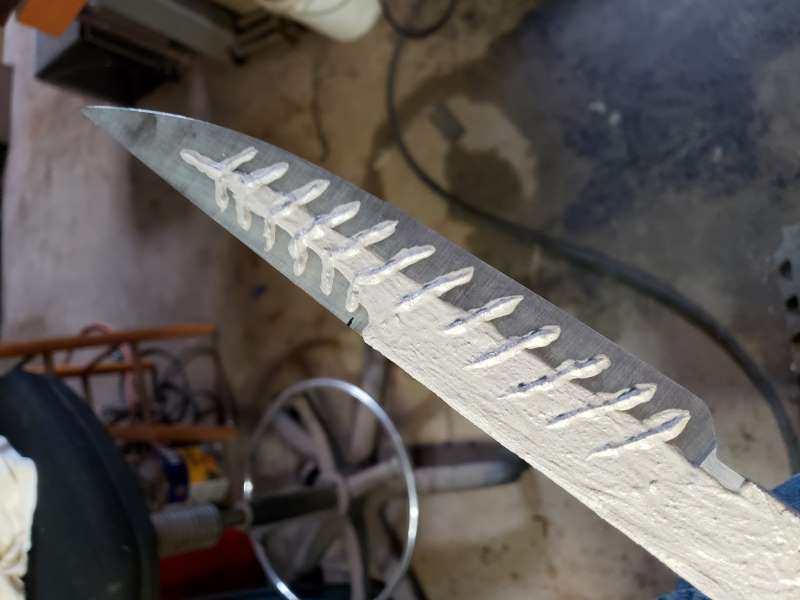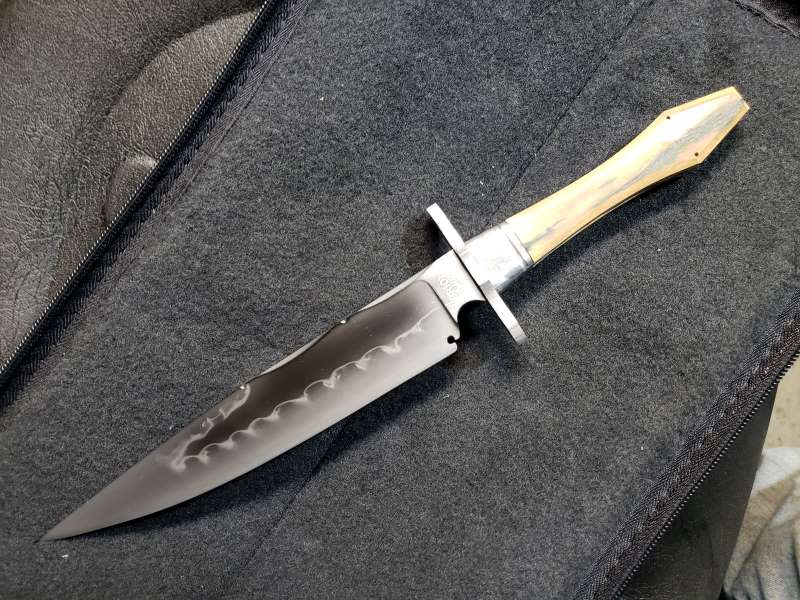Hello, I recently finished a bowie knife with a hamon. I got the hamon line but it isn't exactly as I expected. I thought the line would look like the way I laid the clay, but it came out less wavy and I got no line near the false edge (although it had no clay).
As "clay" I used a refractory cement with a little bit of coal dust and clay. I used 1080 steel, the knife was polished to 220 grit before hardening and it was quenched in canola oil heated to 120F. I left it in the oil for 15 to 20 seconds after quenching.
I think the problem may be the clay thickness, the fact that my oil recipient was not big enough (it is a cylinder 5.3 inches wide and 10.2 deep) or that my clay did not have exactly the same shape on both sides. But I am not sure and would like your help to better control the hamon.
I have here a photo of the blade with the clay (you can see I wanted a wavier line) and of the finished knife (the line is straighter, comes close to the edge near the ricasso and the false edge wasn't fully hardened).
Thank you,
Pedro.
I often refer to creating a hamon as a "dance" between the bladesmith, the steel and the forge.
There are more factors involved than you mention.
HOW! you have the steel set-up to harden is also a factor. If the blade was forged, did you do proper thermal cycling post-forging to have the steel ready to harden?
Did you get the steel hot enough to have all the carbon in solution?
How much of the steel did you have in austenite? Just the cutting edge or the entire blade?
One thing not dialed in correctly will effect the end result.
When I want to create a hamon I use W1 or W2 as either one is very shallow hardening. I have never tried 1075/80 so I have no reference on that type of steel, although I have seen many good results using those.
When I first starting learning hamons, I had far more failures than successes.
If I were you, I would try leaving the edge more radical up and down like sharp teeth. Make very pointy lows and leave the gaps higher up.
It will take time - but what you have there is already a success.
Try to pay really close attention to all of your details and learn from each attempt.
Karl B. Andersen
Journeyman Smith
Thank you Karl Andersen, in the next time I will make the edge more radical as you said. About the steel set-up, I thermal cycled twice (once before ginding and once before hardening), and I tried to get all the blade a bit above non magnetic before quenching (about 5 seconds in the forge after my magnet stopped working).
Hello Pedro. Good questions. Usually when you see the hamon low on the blade either it did not get hot enough, the clay was too thick, or the quenchant was not fast enough. It could be a combination of the above. As Karl stated you need to set up the blade for hardening. I normalize after forging. Once at 1600-1650F, then air cool to black. Then one at 1500F and air cool to black, then at 1300F and slow cool.
I do not use wire to hold the clay on. I have never needed it. I grind my blades to a clean 120 grit and apply the clay, then allow to dry overnight or use a heat gun to dry it. Them bring up to 1475F and soak at that temp. I use W2, with your 1080 you may not need a soak, but the blade must be thoroughly and evenly heated. My clay thickness is around 1/16 of an inch with ashi lines being almost 1/8 of an inch.
Your canola at 120F should work fine, I use a fast oil called parks 50. This is the result.
Try experimenting with the clay thickness and without the wire wrap. Hope this helps.
Brion
Brion Tomberlin
Anvil Top Custom Knives
ABS Mastersmith
Thank you Brion, and very beautiful knife. I am building an electric oven, so I will have better temperature control in the future. I see you and Karl use W2 steel, can I use it with canola oil? I can't find parks 50 in my country.
Pedro, somewhere on this forum is a treatise by ABS MS John White on Hamon production. I have it in an Adobe .pdf document. His technique has never failed me. If you like, I can send it your way.
Just PM me your email address.
Joshua States
www.dosgatosforge.com
https://www.youtube.com/channel/UCdJMFMqnbLYqv965xd64vYg
https://www.facebook.com/dos.gatos.71
Also on Instagram and Facebook as J.States Bladesmith
“So I'm lightin' out for the territory, ahead of the scared and the weak and the mean spirited, because Aunt Sally is fixin’ to adopt me and civilize me, and I can't stand it. I've been there before.â€
Thank you Joshua, I sent you my email.
Yes Pedro, canola heated to 110-120F will work. But a larger volume of oil will help.
Brion
Brion Tomberlin
Anvil Top Custom Knives
ABS Mastersmith
Beautiful knife and hamon Brian, thank for the tips. As always when I visit this site I learn something different.



